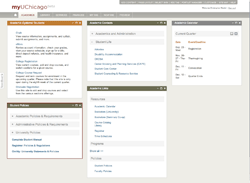myUChicago is Coming
 For the past several weeks many groups across campus have been busy putting the final touches on the University’s new Web portal, myUChicago. If you haven’t heard about it already, you will soon.
For the past several weeks many groups across campus have been busy putting the final touches on the University’s new Web portal, myUChicago. If you haven’t heard about it already, you will soon.
The plan is to begin a phased rollout of myUChicago beta, beginning November 18. Over a three-week period (Nov. 18-Dec. 7) College, graduate and professional students will gain access to the site.
Resources for faculty are scheduled to launch in winter quarter, with a staff launch planned for spring quarter.
So, why the blog?
Throughout the development process we’ve fielded a lot of questions surrounding myUChicago—what it is, what it does, why you should care—and we thought it might be useful to have a venue to provide some answers, as well as updates on the project, tips for using the site, along with other timely, relevant information.
With that in mind, we are using this first post to address some of the most commonly asked questions.
What’s a portal?
Chances are, you’re already using one. A portal is essentially a framework for aggregating content relevant to your unique interests. Its main purpose is to provide easier access to information from a range of sources. Portals you may be familiar with include iGoogle, My Yahoo, and the MSN homepage.
Why is it called myUChicago?
The University’s portal project was driven by the notion that every member of the University community has specific needs based on who they are. Students need one set of tools, faculty another, staff yet another. Even within those groups, the tools you need change as the year progresses or your career evolves. myUChicago gives you access to what you need; it also gives you the flexibility to change what you see and how you see it. So it’s not just “a” portal; it’s “my” portal. That’s why it’s myUChicago.
What will I find in myUChicago?
myUChicago is meant to be a stepping stone to some of the most commonly used University websites. You can use the portal to find:
- Personalized content and information
- Contacts for various offices and services
- Links to dozens of sites from around campus
- Single sign on access to select University resources
- Custom search tools
- And more
In fact, you can see a full list of the custom content built specifically for the university here.
Will myUChicago replace Chalk?
No. myUChicago is intended to be a doorway to a range of University and community content. It will not replace other systems that are currently in use, rather it will provide simplified access to many of the tools you need on a day-to-day basis, including Chalk.
Why do I need another website?
myUChicago is built to be more than just a website; and the beta version we’re launching soon is just the beginning. Future plans include building better tools for managing your academics or your career at the University and consolidating outdated sites and applications into a more cohesive suite of services. The result will be a robust toolkit that minimizes the need to remember more than a single URL: my.uchicago.edu.
Where can I get more information?
Over the next several weeks you will see increased communication about the portal all over campus. As we get closer to launch, you will receive email with specific information about individual access. Over the next several months, this blog will serve as a resource to the campus community, as well as a forum to voice your opinion, suggestions, and thoughts about myUChicago.
An article about the portal—published in the September edition if iNSITe—can be found here. You should also feel free to browse the myUChicago help site.
Categories
Portal News , Welcome to myUChicago0 TrackBacks
Listed below are links to blogs that reference this entry: myUChicago is Coming.
TrackBack URL for this entry: https://blogs.uchicago.edu/cgi-bin/mt/mt-tb.cgi/190



Leave a comment